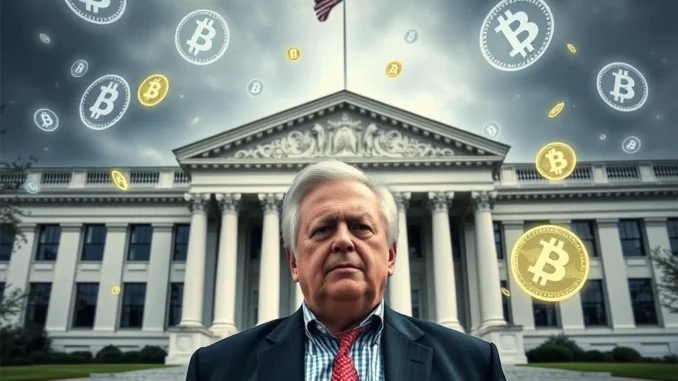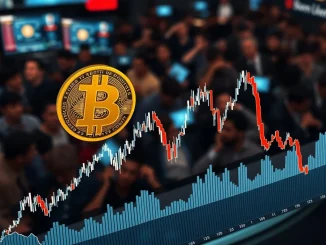
In a critical move that has sent ripples through the cryptocurrency world and Washington D.C., Representative Gerry Connolly of Virginia has stepped forward to challenge the U.S. Treasury’s ambitious plans for a strategic crypto reserve. This development arrives amidst growing debates about crypto regulation and government oversight, raising vital questions about the future of digital assets in the United States. Is this a necessary safeguard or a potential pathway to conflicts of interest? Let’s dive into the details of this unfolding situation.
Understanding the Strategic Crypto Reserve Proposal
The concept of a strategic crypto reserve might sound novel, but it’s rooted in the traditional idea of strategic reserves for essential commodities like oil. The U.S. Treasury, under Secretary Scott Bessent, has reportedly been exploring the creation of a similar reserve for cryptocurrencies. The aim, as perceived by some, could be to bolster U.S. influence in the digital asset space, potentially stabilize markets, or even prepare for future financial scenarios where digital currencies play a more dominant role. However, the exact motivations and operational details of this proposed reserve have remained largely under wraps, fueling speculation and, as we are seeing, opposition.
Why might the Treasury consider a strategic crypto reserve?
- National Security: In an era of increasing digital threats, controlling a significant crypto reserve could be seen as a strategic asset.
- Market Influence: A large reserve could give the U.S. government leverage in crypto markets, potentially mitigating volatility.
- Financial Innovation: Embracing crypto through a reserve could signal a proactive approach to financial innovation.
Congressman Connolly’s Urgent Concerns About Crypto Regulation and Potential Conflicts
Enter Congressman Gerry Connolly, a vocal Democrat from Virginia and a member of the Oversight Committee. On March 13th, Connolly penned a letter to Treasury Secretary Bessent, expressing urgent concerns about this very strategic crypto reserve proposal. His primary worry? Potential conflicts of interest involving former President Donald Trump. According to a press release from the Oversight Committee Democrats, Connolly believes this initiative could disproportionately benefit President Trump and his donors, rather than serving the broader American public. This is a serious accusation, injecting a layer of political controversy into an already complex financial matter.
Connolly’s letter highlights several key issues regarding crypto regulation and the proposed reserve:
- Conflict of Interest: The central argument revolves around potential undue influence and financial gain for President Trump and his associates.
- Lack of Congressional Consultation: Connolly emphasizes that the Treasury Department developed this plan without consulting Congress, raising questions about transparency and proper procedure.
- Public Benefit vs. Private Gain: He questions whether the reserve is truly in the public interest or primarily designed to enrich specific individuals or groups.
Diving Deeper into the Conflict of Interest Allegations
The specter of conflict of interest is a serious one. Connolly’s concerns suggest a fear that a strategic crypto reserve, if not carefully structured and transparently managed, could become a tool for political patronage or personal enrichment. Without explicit details from the Treasury, it’s difficult to assess the validity of these concerns definitively. However, the lack of transparency surrounding the proposal itself arguably lends credence to Connolly’s call for scrutiny.
Transparency and accountability are paramount, especially when dealing with public funds and potentially volatile assets like cryptocurrencies. For a crypto regulation framework to be effective and trusted, it must be free from even the appearance of impropriety. Connolly’s letter serves as a stark reminder of this principle.
The Broader Landscape of Treasury Crypto Plans and Crypto Regulation
This controversy unfolds against a backdrop of increasing regulatory activity around cryptocurrencies. Globally, governments are grappling with how to manage digital assets, balance innovation with risk, and protect consumers. The U.S. Treasury itself has been playing a significant role in shaping crypto regulation, working with other agencies to develop a comprehensive approach.
Here’s a snapshot of the evolving treasury crypto plans and regulatory landscape:
| Area | Current Focus | Challenges |
|---|---|---|
| Anti-Money Laundering (AML) | Strengthening AML/KYC requirements for crypto exchanges and services. | Anonymity features of some cryptocurrencies; cross-border transactions. |
| Taxation | Clarifying tax rules for crypto transactions and holdings. | Complexity of crypto transactions; reporting and enforcement. |
| Consumer Protection | Educating consumers about crypto risks; preventing fraud and scams. | Rapid evolution of crypto space; decentralized nature of many projects. |
| Financial Stability | Assessing the potential systemic risks posed by cryptocurrencies. | Interconnectedness of crypto markets with traditional finance. |
Gerry Connolly Crypto Stance: A Pro-Regulation Advocate?
While Connolly’s recent letter specifically targets the strategic crypto reserve, it’s important to understand his broader stance on crypto regulation. His actions suggest a cautious approach, prioritizing oversight and transparency. By raising concerns about potential conflicts of interest and lack of congressional consultation, he’s signaling a belief that any government involvement in the crypto space must be subject to rigorous scrutiny and democratic processes.
It’s worth noting that Connolly has been a consistent voice for government accountability and ethical conduct. His intervention in this matter aligns with his broader political principles and suggests a commitment to ensuring that crypto regulation serves the public interest, not private agendas.
What Happens Next with the Crypto Reserve and Crypto Regulation?
The future of the strategic crypto reserve proposal now hangs in the balance. Connolly’s letter puts significant pressure on the Treasury Department to respond and address the raised concerns. We can anticipate several potential scenarios:
- Treasury Response and Clarification: The Treasury might issue a public statement clarifying the rationale behind the reserve and addressing conflict of interest concerns.
- Congressional Inquiry: Connolly and other members of Congress could push for formal inquiries or hearings to investigate the proposal further.
- Revision or Abandonment of the Plan: Faced with political opposition and public scrutiny, the Treasury might revise the plan or even abandon it altogether.
- Increased Scrutiny of Crypto Regulation: This episode could trigger a broader debate about the need for more robust and transparent crypto regulation frameworks.
Conclusion: A Critical Juncture for Crypto Regulation
Representative Connolly’s challenge to the Treasury’s strategic crypto reserve plan marks a critical juncture in the ongoing saga of crypto regulation in the United States. It underscores the inherent tensions between innovation, national interest, and political accountability in the rapidly evolving world of digital assets. Whether this proposal moves forward, is modified, or is scrapped entirely, one thing is clear: the debate over government involvement in crypto is far from over, and voices like Connolly’s will play a crucial role in shaping its future. The coming weeks and months will be telling as we watch how the Treasury and Congress navigate this complex and urgent issue.



